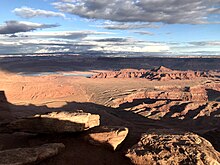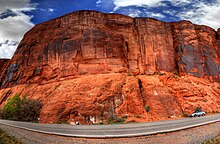 State Route 279 State Route 279 | ||||
|---|---|---|---|---|
| Potash-Lower Colorado Scenic Byway | ||||
| Route information | ||||
| Maintained by UDOT | ||||
| Length | 15.178 mi (24.427 km) | |||
| Existed | 1960–present | |||
| Major junctions | ||||
| South end | Potash mine along Colorado River | |||
| North end | ||||
| Location | ||||
| Country | United States | |||
| State | Utah | |||
| Highway system | ||||
| ||||
| ||||
State Route 279 is a state highway in the U.S. state of Utah. The highway was constructed in 1962–1963 to service the Cane Creek potash mine and processing plant southwest of Moab. The highway was named one of the most beautiful highways opened to traffic in 1963. The entire length of SR-279 has been designated the Potash – Lower Colorado River Scenic Byway by the Utah State Legislature, however is known locally as Potash Road.
This highway was intended to be part of a longer highway, State Route 278, that was to scale the canyon walls between Moab and Dead Horse Point State Park. Only the connection to the potash mine was constructed before the project was cancelled. Although the highway was constructed to aid the mining industry of southeastern Utah, the road is popular with tourists and four wheel drive enthusiasts. The jeep trails beginning where SR-279 ends are used to access Canyonlands National Park and Dead Horse Point.
Route description

The highway begins just north of Moab at a junction with U.S. Route 191 near the southern boundary of Arches National Park. The road follows the north bank of the Colorado River to the potash mine. The road is legislatively designated north–south, but actually serpentines for most of its length. The highway loosely parallels a spur of the Denver and Rio Grande Railroad built at the same time and for the same purpose of serving the potash mine. The route of the railroad features a 1.59-mile (2.56 km) tunnel that bypasses most of the serpentine bends in the Colorado River between Moab and the potash plant. While in the Colorado River canyon, the highway passes by dinosaur footprints, Indian petroglyphs and jeep trails leading to Canyonlands National Park and Dead Horse Point State Park. The highway also passes by three named natural arches, Corona Arch, Bow Tie Arch, and Jug Handle Arch.
History

The State Road Commission approved a new State Route 279 in 1960, connecting US-160 (now US-191) northwest of Moab with Dead Horse Point State Park. The route would be mostly new construction, following the right (northwest) bank of the Colorado River to Day Canyon, where it would climb to the southwest onto the plateau containing the park. Within the park, an existing roadway, then its primary access road, would become part of SR-279. The state legislature approved this highway in 1961. Later that year, the commission added a second route—State Route 278—that would continue south alongside the river from SR-279 to the Grand-San Juan County line. However, when it approved the addition in 1963, the legislature made it part of SR-279, renumbering the spur to the park through Day Canyon as SR-278. In addition, the south end of SR-279 was changed to Potash, a point north of the county line where the Texas Gulf Sulphur Company was building a potash plant. SR-279 was soon built, but the road through Day Canyon was never constructed. In 1975, the legislature deleted SR-278 in favor of a new SR-313, which followed the existing county road to Dead Horse Point through Sevenmile Canyon.


In 1963, Parade Magazine held the third of an annual competition for most scenic highway that opened to traffic that year. SR-279 was one of four finalists in the competition. The others finalists were I-93 between Windham and Londonderry in New Hampshire, I-84 near Southington, Connecticut and I-405 near Sepulveda Pass in Los Angeles, California.
Major intersections
The entire route is in Grand County.
| Location | mi | km | Destinations | Notes | |
|---|---|---|---|---|---|
| | 0.000 | 0.000 | Potash Plant | Southern terminus | |
| | 1.678 | 2.700 | Jug Handle Arch View area | ||
| | 5.123 | 8.245 | Gold Bar Recreation Area and Campgrounds | ||
| | 5.294 | 8.520 | Corona Arch/ Bow Tie Arch parking area | ||
| | 9.390 | 15.112 | Dinosaur Footprints View Area/Poison Spider Mesa Trailhead | ||
| | 9.726 | 15.652 | Williams Bottom Camping Area | ||
| | 11.184 | 17.999 | Jaycee Park Recreation Site | ||
| | 15.178 | 24.427 | Northern terminus | ||
| 1.000 mi = 1.609 km; 1.000 km = 0.621 mi | |||||
See also
- State Route 128 – Upper Colorado River Scenic Byway
References
- ^ "Highway Reference Online - SR 279". maps.udot.utah.gov. Utah Department of Transportation. Retrieved May 18, 2008.
- ^ "Potash/Colorado River Scenic Byway". Utah Office of Tourism. Retrieved August 7, 2007.
- ^ "Scenic Drives in the Moab Area". Moab Area Travel Council. Retrieved May 18, 2008.
- Utah Road and Recreation Atlas (Map). 1:170000. Benchmark Maps. 2002. p. 71. ISBN 0-929591-74-7.
- "State Road Resolutions SR-279.pdf". Utah Department of Transportation. Retrieved May 1, 2008.
- Utah State Legislature (1961). "Chapter 58: Designation of State Roads". Session Laws of Utah.
Route 279. From junction with route 9 north of Moab, southwesterly down the right side of the Colorado River via Gold Bar and Day Canyon to Dead Horse Point.
- ^ "State Road Resolutions SR-278.pdf". Utah Department of Transportation. Retrieved May 1, 2008.
- New York Times, Texas Gulf Sulphur Plans Big Utah Potash Project, September 27, 1960, p. 49
- Utah State Legislature (1963). "Chapter 39: Highway Code". Session Laws of Utah.
Route 278. From Dead Horse Point easterly to route 279 near Day Canyon. Route 279. From the Potash Plant north along the Colorado River to route 9 north of Moab.
- "America's Prize Winning". Modesto Bee And News-Herald. October 20, 1963.
- Mark D. O'Neil. "Scan of 1964 Utah Department of Highways official map". Retrieved August 13, 2007.
Categories: